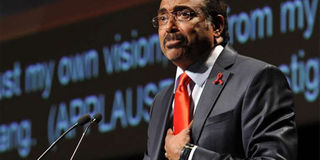Wanted: New ways to fund HIV treatment

UNAIDS Executive Director, Michel Sidibe speaks during the opening ceremony of the 20th International AIDS Conference in Melbourne on July 20, 2014. Kenya must explore how best to risk-pool for HIV treatment through insurance options and invest in HIV prevention and stop the tide of new infections. PHOTO | ESTHER LIM |
What you need to know:
- Thirteen years ago, the cost of treatment for HIV and Aids was approximately $15,000 (about Sh1.5 million at today’s exchange rate) per person per year.
- It will cost about Sh17.2 billion to provide anti-retroviral therapy to 850,000 people this year.
- What is clear for Kenya is that, first, we must explore how best to risk-pool for HIV treatment through insurance options.
- Second, we must explore sustainable HIV financing mechanisms that will allow us to leverage and complement non-exchequer resources for prevention and research while contributing to the broader health agenda.
- Most importantly, we must invest in HIV prevention and stop the tide of new infections.
Thirteen years ago at the Durban Aids Conference, where this year’s Aids Conference will be held, Nkosi Johnson, a 12-year-old South African boy born with HIV, brought the world to tears.
In just one speech this boy delivered before presidents and other dignitaries, the HIV response shifted and with it, the human rights paradigm became a central part of the health sector.
Global financing mechanisms were created and the idea for what we now call “big pharma”, which subsidises ARVs, was born. This was unprecedented.
Before the conference, it had been argued in many forums that scaling up ARV treatment in Africa, which had the highest HIV infection rate in the world, would be unsustainable because Africans could not keep time and hence would not adhere to the strict regimen of the medication used to manage the infection.
Another concern was that poverty-stricken Africans would not afford the cost of medication.
However, many activists and global figures involved in the HIV response rejected those theories, arguing that with availability of ARVs, it was unacceptable that an HIV-positive result should continue to be a death sentence for many people.
TREATMENT COST CHEAPER
Thirteen years ago, the cost of treatment for HIV and Aids was approximately $15,000 (about Sh1.5 million at today’s exchange rate) per person per year.
Today, this cost is $200 (Sh20,000) for generics.
It will cost about Sh17.2 billion to provide anti-retroviral therapy to 850,000 people this year.
This is almost 30 per cent of Kenya’s annual health budget.
This cost does not include the money required for HIV prevention or treatment of HIV-related opportunistic infections, including cancers.
Importantly, without a vaccine or a cure, this is a recurrent cost that must be met over the next 50 to 70 years.
Kenya, like many African countries, is not able to meet the full cost of the medication and continues to receive support from global organisations.
Nkosi died in 2001 just as the price of ARVs was beginning to drop and access to generics was safeguarded through instruments such as the Trade and Related Intellectual Property Rights and public health flexibilities.
ACCESS TO GENERICS
At the World Trade Organisation meeting held in Nairobi in December last year, continued access to generics by higher income countries such as Kenya was one of the gains made, although it was contentious.
With Kenya’s successful scaling up of anti-retroviral therapy, one cannot help but reflect on the arguments that governed the management of HIV in the late 1990s.
Can we afford treatment? Are we able to incur the economic liability of ARVs from the National Treasury?
With the flat-lining and likely decline of donor funds for HIV, might we have shifted from a death sentence to a debt sentence?
What is clear for Kenya is that, first, we must explore how best to risk-pool for HIV treatment through insurance options.
Second, we must explore sustainable HIV financing mechanisms that will allow us to leverage and complement non-exchequer resources for prevention and research while contributing to the broader health agenda.
Most importantly, we must invest in HIV prevention and stop the tide of new infections.
Otherwise, we risk expanding the pool of people who need treatment in the future, without the means to finance this.
Dr Kilonzo is director, National Aids Control Council.




